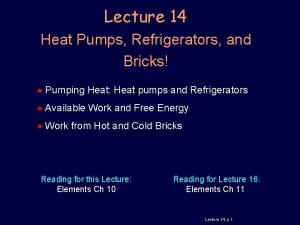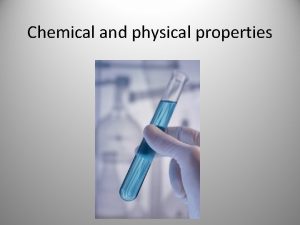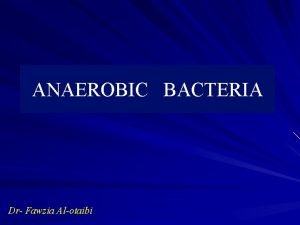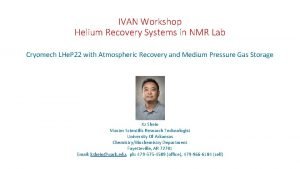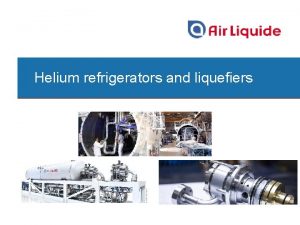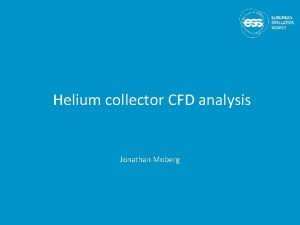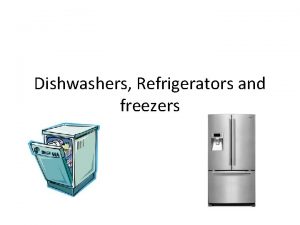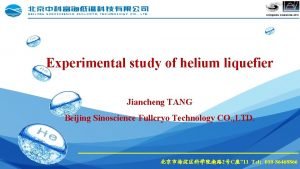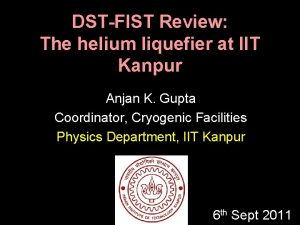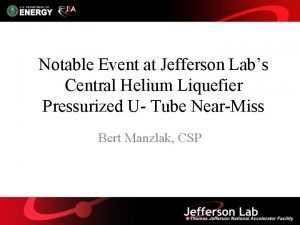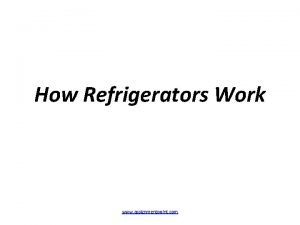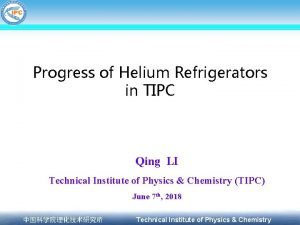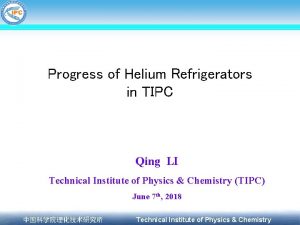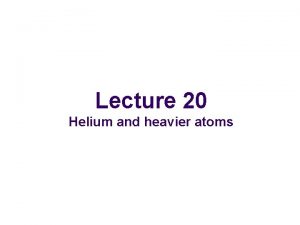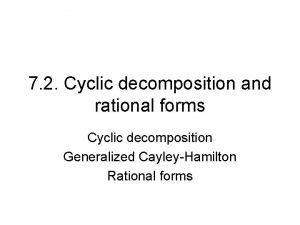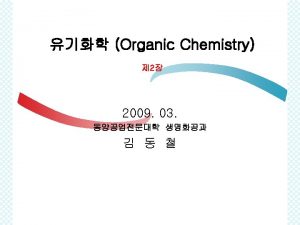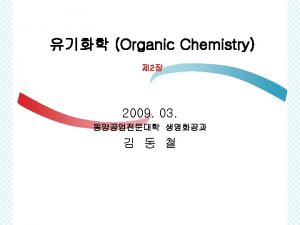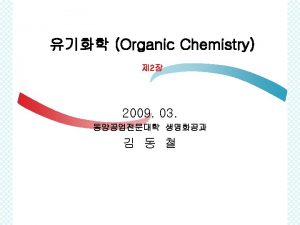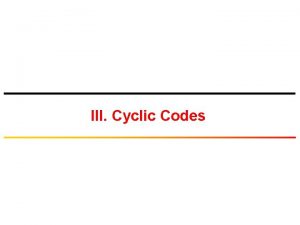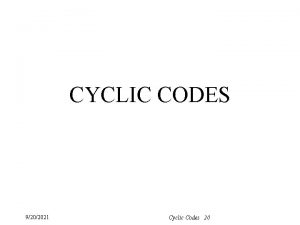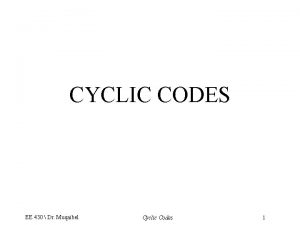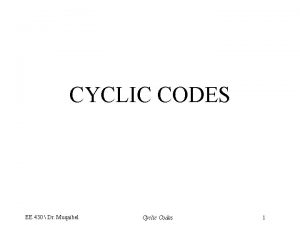Indigenous Development of Helium Liquefier and Cyclic Refrigerators






































- Slides: 38

Indigenous Development of Helium Liquefier and Cyclic Refrigerators P K Kush Head, Cryo Engineering and Cryo Module Development Section Raja Ramanna Centre for Advanced Technology, Indore, INDIA Email: kush@rrcat. gov. in Web: www. rrcat. gov. in

India’s First Indigenously Developed Helium Liquefier

Components of a Helium Liquefier Ø Expansion Devices Ø Heat Exchangers Ø Thermal Insulation system (Cold Box) Ø Process Control Components Ø Thermally Insulated Transfer Lines Ø Main Dewar (To collect Liquid) Ø Cyclic Compressor

Schematic of a Helium Liquefier

Cryogenic Expansion Engine: A Critical part in Claude/ Collins cycle based cryogenic refrigerators and liquefiers Types of Expansion Engines Reciprocating Type Turbine Type Reciprocating Type Expansion Engine Ø Ø High Expansion Ratio Low Flow Rate Constant Efficiency Over Wide Range of Operating Conditions. Less Sensitive to Contamination and Power Fluctuation Problems Ø Control of Speed/ Flow Rate is Easier

Expansion Engines 3 D Model of expansion engine developed at RRCAT Photograph showing expansion engine along with heat exchangers and auxiliary components. 1. Cryogenic Expander, 2. Work extraction mechanism, 3. 1 st heat exchanger, 4. Flywheel

Expansion Engines Actual P-V Diagram, near Room Temperature Expansion Cycle Actual P-V Diagram, at low Temperature

Expansion Engines Graph showing condition when both Inlet and exhaust valves are leaking Distorted P-V Diagram due to valve leakage Graph showing condition better leak tightness of valves

Valves to seal at Cryogenic Temperature

Expansion Engines Parameters for 1 st Expansion Engine Diameter: 75 mm, Stroke: 50 mm, Engine speed: 120 rpm Inlet cam opening angle: 50 deg Inlet gas pressure: 17. 21 bara, Inlet Temp. , K Expander Eff. , % Mass flow rate, g/s 300 77 0. 22 80 68 0. 80 50 64 1. 26 Parameters for 2 nd Expansion Engine Diameter: 50 mm, Stroke: 50 mm, Engine speed: 120 rpm Inlet cam opening angle: 45 deg, Inlet gas pressure: 17. 21 bara, Inlet Temp. , K Expander Eff. , % Mass flow rate, g/s 300 86 0. 08 80 81 0. 29 25 75 0. 92

Expansion Engines Stress analysis of expander liner Temperature profile using 80 K anchoring

Heat Exchangers Ø Low losses of use full refrigeration through § Heat Conduction through solid material – long length § Through radiation – lower surface area 300 K Ø Very low pressure drops – critical pressure for helium: 2. 2 bar absolute Ø Heat Transfer – One side high pressure helium (about 230 psig) – Other side Very low pressure Helium (about 2 psig) 80 K

Heat Exchangers Heat Transfer area/ Volume (m 2/ m 3) 700

Heat Exchangers Photograph of heat exchanger HX-6 before final welding Specifications of heat exchangers HX- # Efficiency, (%) Fin Tube Heat transfer area (m 2) HX-1 95. 5 2. 45 HX-2 95. 7 2. 14 HX-3 94. 7 1. 53 HX-4 94. 9 0. 53 HX-5 96. 6 0. 72 HX-6 95. 7 0. 92

Cyclic Compressor Make: Sulzer India, Four Stage, air cooled, oil Lubricated, Reciprocating type (Suitably modified for using it with above expansion engine) Oil Removal System: Designed, Processed and commissioned by us. (Fabricated by local fabricator)

Process Integration of Components Ø Cyclic Compressor – Suitable compressor lubricating oil – Efficient oil removal system Ø Quality welding and brazing – problem of “cold leaks” Ø Processing of components Ø Pressure Control and Helium Gas management system – 740 liters (NTP) produces 1 liter liquid

Helium gas recovery compressor and Gas recovery bags

Helium Liquefier Developed at RRCAT

Liquefaction Temperature reading of the sensor put inside the liquid helium collection container after J-T valve, when liquefaction was approached for the first time.

Present Status • Helium Liquefier developed at RRCAT has been operated more than 6 times so far • Each time it was operated till the main Dewar was filled to safe limit - 200 liter • Nearing 1, 000 hours of operation – no breakdown

Team Members Samir Ranjan Sardar, Om Prakash, Krishna Kant Mahawar, Ravindra S. More, Pawan Kumar, Radha Krishan Pathak, Nakka Sathi Babu, S K Joshi, Ashok Kumar Dewangan, M S Ansari, Ravi Sharma, Chetan Singh Sunil Kamthre.

Development of Cyclic Refrigerators – 30 K Cryocoolers – 10 K Cryocoolers – Cryopump with pumping speed of 1, 200 liters/sec for air

• Cryocoolers like domestic refrigerator require only electricity to produce low temperature. The Cryocoolers developed at RRCAT are based on Gifford Mc. Mahon Cycle. They produce 30 K in a single-stage system and 10 K in a two-stage system. The entire cryocooler is made of indigenously available components. • The Cryocooler consist of two parts, an expander module and a compressor module. • The Cryocooler uses Helium gas as working fluid.

Development of Cyclic Refrigerators 30 K Cryocooler 10 K Cryocooler

3 D Design Model Product Photograph

Reference: “Low-power cryocooler survey”, H. J. M. ter Brake, G. F. M. Wiegerinck, Cryogenics 42 (2002) 705– 718. (Data of 235 cryocoolers made world wide) Cryocooler developed by RRCAT: Compressor power 2. 19 k. W. Cooling power 27. 89 w at 80 K

30 K CCR supplied to user Labs. 06 Numbers of 30 K systems are supplied to different labs + One Compressor Module matched with imported unit and supplied to BARC, Mumbai, Year 2002.

(1) One 30 K Cryocooler supplied during first half of year 2004 (Laser Physics Applications Division, RRCAT), It is being used for study of “Temperature Dependent Transient Photoconductivity & Photoluminescence of Organic Semiconductors” Sample Holder

(2) Another 30 K Cryocooler was supplied to Semiconductor Laser Section, RRCAT during year 2004. It is being used to study “Temperature Dependent Electrical Transport measurements a) Hall Mobility, Carrier Concentration, Resistivity b) Study of J – V and e – V characteristics at low Temperature On semiconductors thin films and optoelectronic structures like lasers, detectors – Regularly grown using MOVPE system at RRCAT

(3) Another 30 K Cryocooler was supplied to Laser Physics Applications Division , RRCAT. It is being used to study “Temperature Dependent Carrier Dynamics measurements by Ultra Fast Pump Probe Spectroscopy”

(4) One 30 K Cryocooler is coupled to a specrofluorometer of Jobin-Vyon (Model no- Fluoromax-3) suitable for experiments in Temperature range of 40 to 300 K. This is being used in a Photoluminescence setup at BARC Spectroscopy Lab RRCAT Indore.

(5) Another 30 K Cryocooler was supplied to Materials, Advanced Accelerator Science Div. : , RRCAT. On this Cryocooler a cryogen free ac-susceptometer working over a wide temperature range (30 -400 K) is developed. Which amongst other things is capable of precision measurements of phase transition phenomenon in magnetic materials and superconductors.

(6) Materials, Advanced Accelerator Science Div. : Resistivity versus Temperature Measurements.

10 K Cryocooler Lowest Temperature – Temperature Stability - <8 K ± 0. 5 deg

Cryocoolers Developed at RRCAT One cryocooler producing a minimum temperature of 7 K is installed in Photophysics beamline at Indus-1 for Matrix Isolation Spectroscopy setup being developed by BARC and IGCAR. 3 D Model during Designing Product Photograph

Cryopump Using Our 10 K G-M Cryocooler • Ultimate Vacuum: 4 x 10 E-8 mbar • Pumping Speed – Nitrogen: 1200 Liter/sec – Argon: 900 Liter/sec • Max. Throughput: 2 mbar. Liter/sec • Impulsive gas load (Cross over) Tolerance: 60 mbar-Liter • Gas Capacity for Nitrogen: 300 Std. liters

Compressor Modules Developed at RRCAT Problems Related with Helium Compressor: • • Helium gas compressors of suitable size are not available in open market. High heat of compression for Helium Gas Suitable Lubricating Oil for clean operation On line Oil removal system for ultra clean high pressure Helium gas All the above problems solved by modifying Commercially available Air. Conditioner Compressor for helium gas. Completed more than 3, 000 hours of operation.

Thank You
 The brick fridges
The brick fridges Aboriginal symbols and meanings
Aboriginal symbols and meanings Hardness property of matter
Hardness property of matter Indigenous axiology
Indigenous axiology Mi'kmaq colors
Mi'kmaq colors Examples of indigenous
Examples of indigenous What is indigenous research
What is indigenous research What is indigenous research
What is indigenous research Indigenous knowledge systems tok
Indigenous knowledge systems tok Indigenous name for forced labour
Indigenous name for forced labour Indigenous aryans
Indigenous aryans World council of indigenous peoples
World council of indigenous peoples Colonization defenition
Colonization defenition Simple machines used by first nations
Simple machines used by first nations Taliban vs western values ap human geography
Taliban vs western values ap human geography What is indigenous flora
What is indigenous flora Kai indigenous game
Kai indigenous game Indigenous crafts in the philippines
Indigenous crafts in the philippines What is an ethnic dance
What is an ethnic dance Lite lincdire
Lite lincdire Indigenous science
Indigenous science Major indigenous settlements in tennessee
Major indigenous settlements in tennessee Introduction to indigenous creative crafts
Introduction to indigenous creative crafts Aboriginal representation in film
Aboriginal representation in film Geo indigenous alliance
Geo indigenous alliance Mental wellness continuum
Mental wellness continuum Defenition of bacteria
Defenition of bacteria Indigenous education in nigeria
Indigenous education in nigeria Indigenous banking system
Indigenous banking system Indigenous rock
Indigenous rock Indigenous thinking in business
Indigenous thinking in business The world's largest universalizing religion is
The world's largest universalizing religion is Combien de ballon d'hélium pour soulever un homme
Combien de ballon d'hélium pour soulever un homme Mezzanine helium
Mezzanine helium Helium recovery bag
Helium recovery bag Bohr diagram of c
Bohr diagram of c Air liquide
Air liquide Fun facts about helium
Fun facts about helium Helium collector
Helium collector
